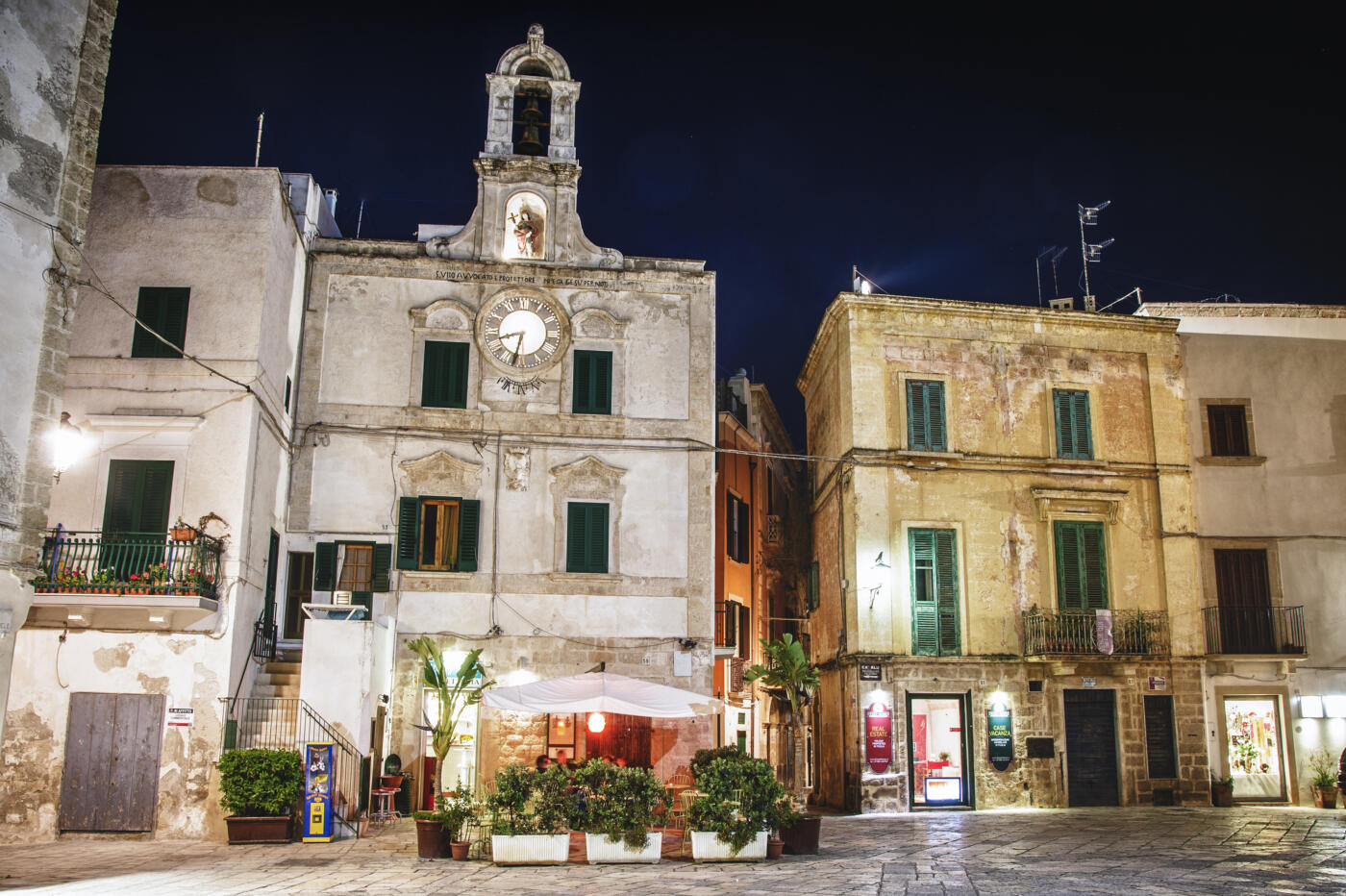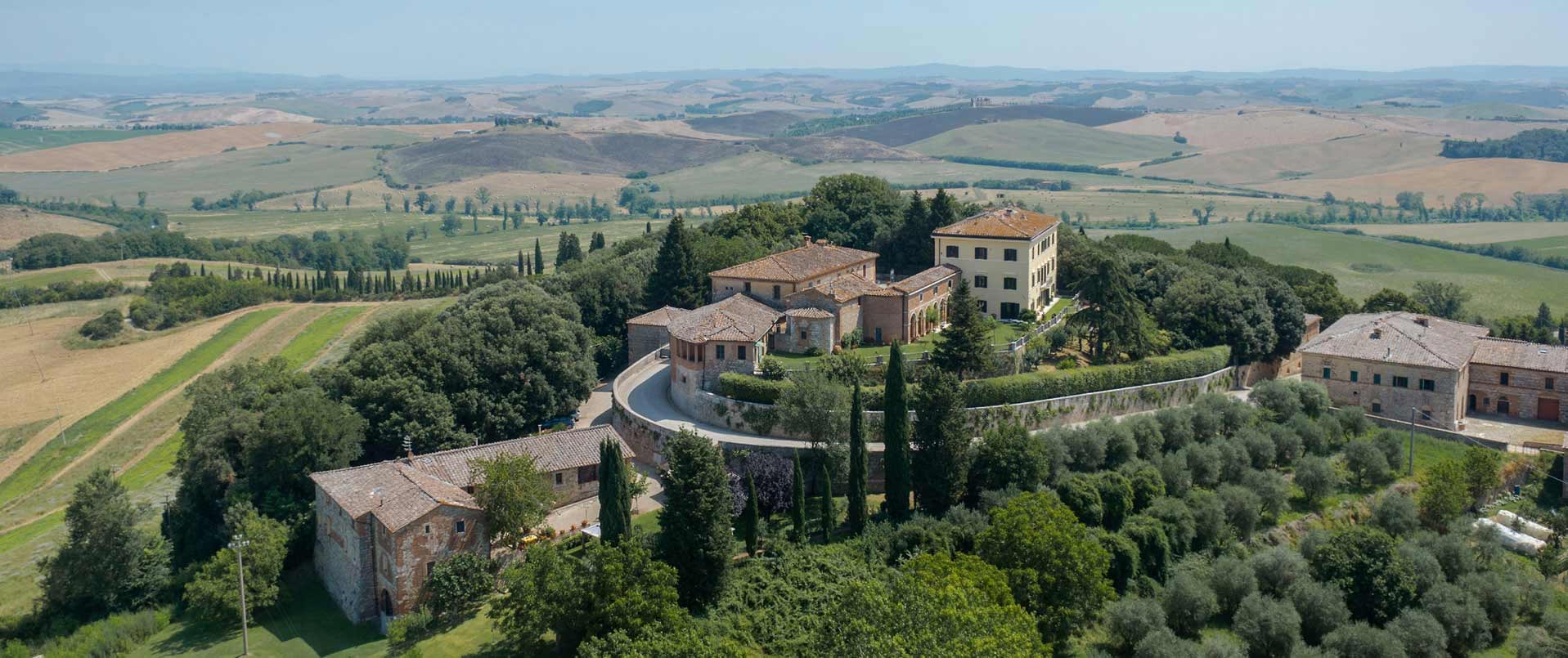
This itinerary takes us through the parts of Puglia that are already on the map and have become an international tourist destination, particularly the area between Bari and Brindisi, while also encompassing the lesser-known areas of Puglia that are poised ready to achieve this status – or at least so we hope, with regard to the region around Taranto. This area has the potential to attract more global visitors, but has been negatively impacted by an outdated development model. Between these two extremities, formed by the Adriatic and Ionian coasts, lies rural Puglia, composed of masseria farmhouses that are now highly sought after by those looking to invest in their restoration, or wanting to secure a country home where they can cultivate olive trees, be part of a an important wine-producing co-operation, or simply invest their savings in a property that is practically guaranteed to increase in value over time. The ever-present risk, however, is that of losing the distinctive character of a territory that is comprised of stunning historical centres supported by a highly functional transport network, especially when compared to other parts of the ‘Mezzogiorno’, as Southern Italy is often called. Let us begin our journey in Bari, then, and discover this regional capital, along with the other splendid realities that are present.
Bari Vecchia, as the ancient part of the city is affectionately named, is now a safe and welcoming area to explore. Visitors can stroll through the city’s narrow streets with ease, a stark contrast to just thirty years ago when it would have been nearly unthinkable for anyone unfamiliar with Bari to venture through these parts to sample the many local food specialities, like the mouth-watering focaccia barese from the renowned Santa Rita bakery. We begin our journey in the San Nicola district, located between Bari’s two ports—old and new—under the towering presence of the Norman-Swabian Castle, offering views of the seafront and a rich history dating back to the Middle Ages. The Basilica di San Nicola is an absolute must-see. Built in 1089 to house the relics of Saint Nicholas of Myra, which are preserved in the basilica’s crypt, this is a significant pilgrimage site for both Catholic and Orthodox believers, and indeed both religious services are celebrated here.
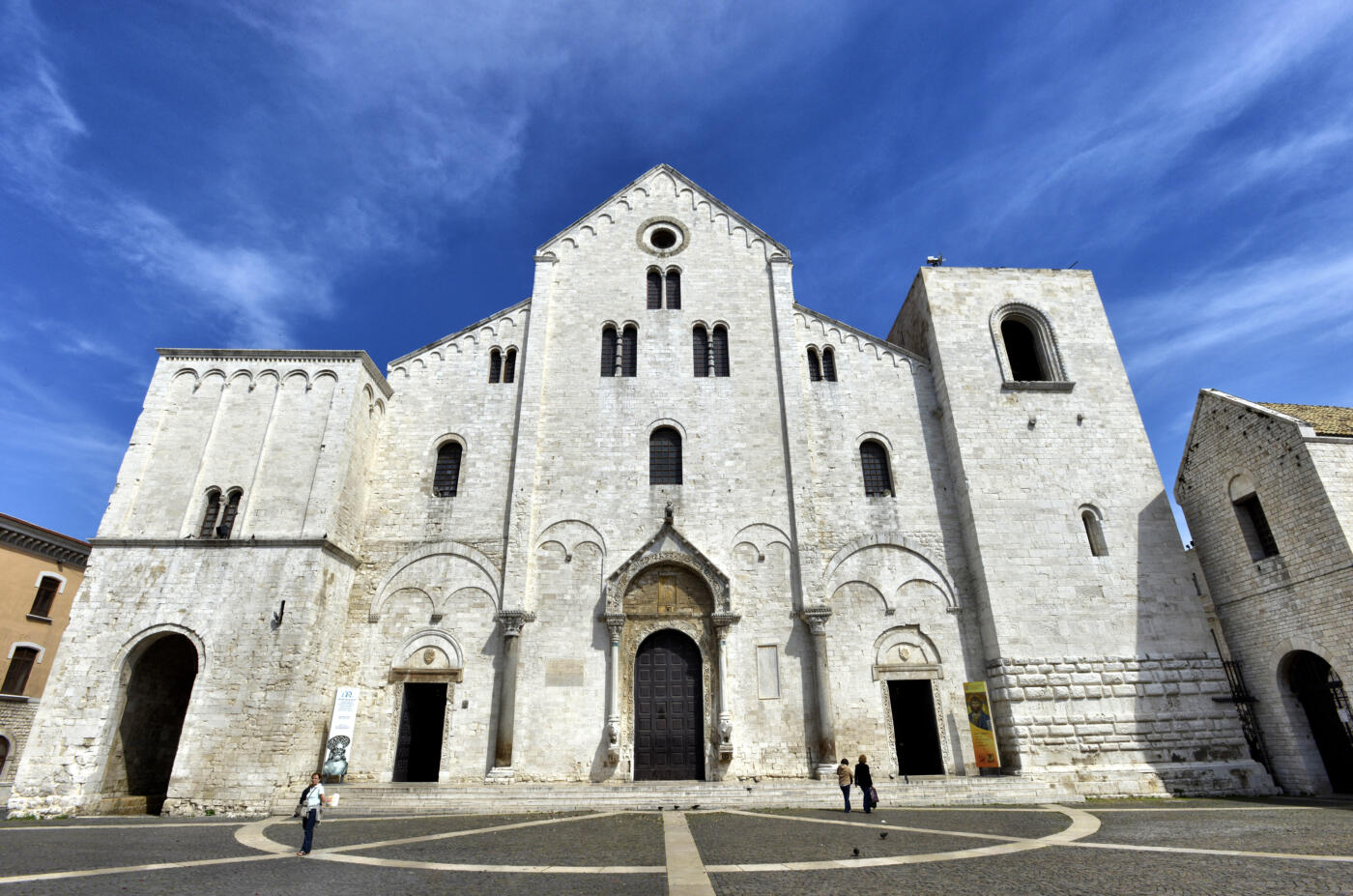
After dedicating at least half a day to the centre of Bari, we suggest you set off southwards along the coast, making your way to Polignano a Mare, the birthplace of singer Domenico Modugno, where there is a statue of him standing on the seafront, arms outstretched in a gesture symbolising the soaring in his iconic and best-known song, ‘Volare’. However, Polignano’s appeal extends well beyond the fame attributed to this globally renowned Italian pop singer; the charming old town is truly delightful and offers postcard-like views, with buildings perched dramatically up on the cliffs above the sea. The incredible marine caves need to be seen firsthand, together with the small beach of Lama Monachile, which is almost always crowded (for a more relaxing experience, we suggest you seek out the Cala San Giovanni, a more peaceful, well-equipped beach club at San Giovanni), and the diving terrace, which is a private residence often used by expert divers for performing impressive stunts. Should you be feeling hungry, head to Piazza Aldo Moro, where you’ll find the original Pescaria restaurant, made famous for its octopus sandwiches and now a trend that has spread its tentacles across Italy! A short distance away, in the direction of Monopoli, stands the monumental complex of Masseria Spina, which is set in a seven-hectare park of centuries-old olive trees. Dating from the 11th to the 18th century, it now serves as a luxury resort and has several restaurants and event venues. The estate also offers a gastronomic tour enabling visitors to experience 1200 years of history, from necropolis to 11th-century Chiesa Minore, from fortified tower called ‘Spina Piccola’ with its inner citrus grove to the ancient underground oil mill, the dyehouse, the external façade of Masseria Spina Grande and the Baroque-style Church of the Immaculate Conception. From here, we move on to a stretch of coastline that has become increasingly popular as a destination for higher-end tourism, due in no small part to the presence of luxury hospitality establishments, such as those in the Egnazia Ospitalità Italiana group (Masseria San Domenico and Borgo Egnazia), which have attracted other major players in the industry, including the Rocco Forte Hotel chain. Follow the coastline past Capitolo, Savelletri and Torre Canne, characterised by the ultra-high prices and a level of luxurious services aimed at meeting the needs of an affluent clientele travelling to these hotels and resorts, notably from North America. We strongly recommend taking a detour to include the National Archaeological Museum and Park of Egnazia and the old town of Monopoli, which features Charles V’s Castle and the ancient port, as well as the dazzling city of Ostuni. The latter is commonly known as the “città bianca” or ‘white city’ due to the unique practice of whitewashing the houses with lime, probably for reasons related to the prevention of spreading disease. The charming historic centre and thriving tourism development, undoubtedly given a helping hand by having an airport close by at Brindisi, have transformed this area into a bustling hub awash with shops, hotels and restaurants. A splendid restaurant with a breathtaking view to try is Operaprima on the very central Corso Vittorio Emanuele.
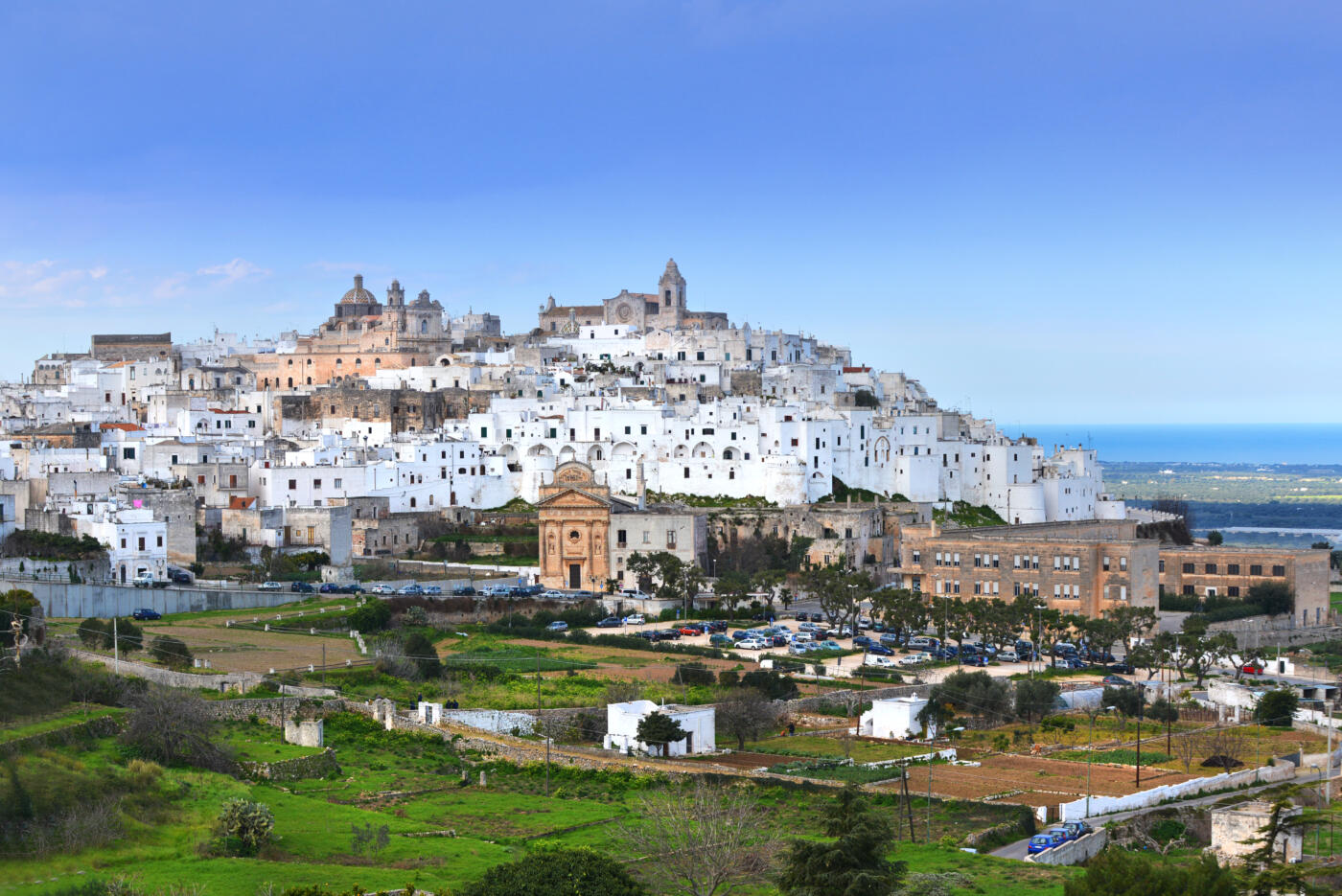
A short distance from the città bianca is the second historical residence on our itinerary, Masseria Paradiso. This 17th-century complex is composed of three buildings arranged in a ‘closed courtyard’ layout. Today, it operates as a B&B, set amidst eight hectares of secular olive groves and orchards, and strategically located both near the sea and within easy reach of the internal Valle d’Itria. A little further on in the direction of Brindisi, in San Vito dei Normanni, is Castello Dentice di Frasso. This is the only castle in the whole region that is still inhabited by its original family. The square tower dates back to 1100, and guests are offered the opportunity of staying there and dining by candlelight, with the fire blazing away in the fireplace during the winter months, or simply touring the site. The medieval town of Ceglie Messapica is a gateway to the heart of inland Puglia, and highlights include the Ducal Castle, the Piazza del Plebiscito and the Clock Tower, which was built in the late 1800s. Heading further inwards towards San Paolo, you will come upon a masseria that serves as the perfect place to base yourself for organising excursions to the surrounding areas, of Martina Franca, Locorotondo and the inimitable Alberobello, renowned for its traditional stone dwellings or trulli, which are instantly recognisable for their conical roofs made from limestone slabs. The Masseria Tagliente farmhouse is a rare example of the past, as it still serves its original purpose as both a holiday home for its owner, as well as an agricultural and livestock business. The main manor house dates back to the mid-19th century and overlooks a property that has always been used for breeding cows, sheep, goats and Murgese horses, the only native Italian breed still in existence. From May to October, the masseria offers bed and breakfast accommodation, and it is also a venue for private events.
Upon leaving the farmhouse, head to Martina Franca, which offers a number of attractions (including the Palazzo Ducale, the Basilica di San Martino and the Chiesa di San Domenico), and is renowned for its high-quality butchers’ shops. These establishments often serve not only as meat vendors, but also as steakhouse bracerie, celebrating traditional grills in the Apulian countryside. Sample local cuisine such as the bombette, which literally means “little bombs” in Italian, referring to the shape of the grilled rolls of meat stuffed with cheese, herbs and spices, and the most popular dish of Martina Franca, capocollo, which is made by seasoning meat with a mix of spices, herbs and salt, then air-drying it for several months. Beware of overdoing it, however, if you also intend to take advantage of shopping for high-end clothing – which requires you to maintain your figure. Tagliatore is a prestigious brand that was founded here and has conquered the global stage with its jackets and suits, while the women’s line is also gaining momentum, with creations by designer Pino Lerario, son of the brand’s founder.
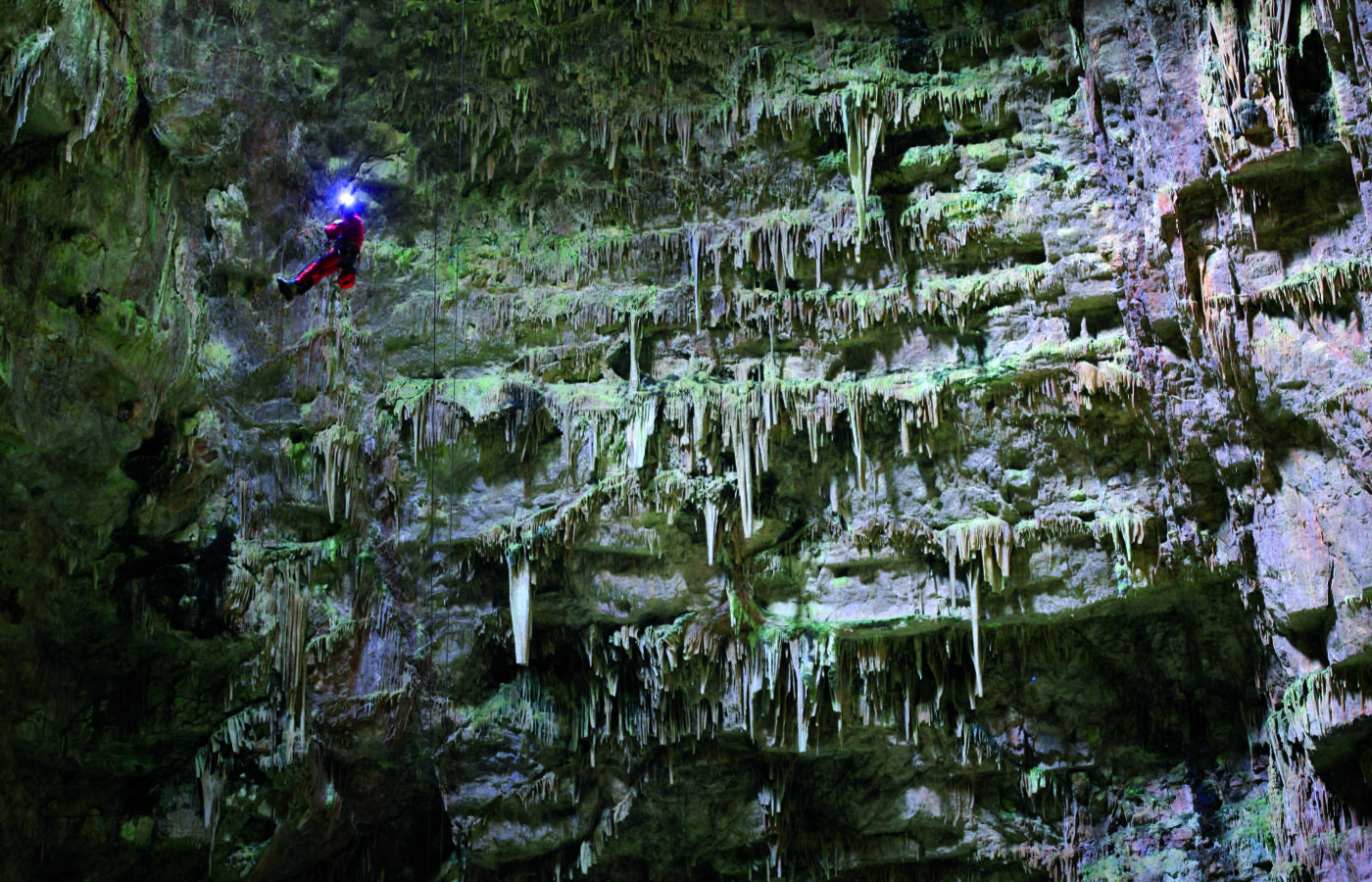
Our journey continues through the Regional Nature Park of Terra delle Gravine, where the unique rock formations have been a source of inspiration for various films and novels. After Palagiano is Masseria San Mama in Castellaneta, close to the Ionian coast and on the border between Puglia and Basilicata. Founded in the second half of the 18th century, it has always belonged to the Giovinazzi di Ducenta marquises and was once home to over a hundred residents, who worked there permanently and even increased in number during the busy harvest period. Today, the masseria serves as a venue for private events and ceremonies.
On the way back to Bari, a stop in Gioia del Colle is essential. This is the dairy capital of Puglia, highly reputed for its superb mozzarella and burrata cheeses. As you are so close, why not include a visit to Putignano, which hosts one of the oldest and most famous carnivals in the whole of Italy, and explore the adjacent underground caverns of the Grotte di Castellana, one of the most extraordinary karst cave systems in Italy. We have a couple of final suggestions for the entroterra inland area around Bisceglie before you wrap up your tour and return towards Bari via Acquaviva delle Fonti. First up is the Dolmen della Chianca, a prehistoric megalithic structure from the Bronze Age. For a grand finale, pay a visit to Villa Fenicia, an ancient fortified farmhouse once dedicated to producing extra virgin olive oil. Now, it serves as a retreat to welcome visitors who, in addition to relaxing in the park and by the swimming pool, can also experience the ethno-botanical dishes prepared by the expert hands of the Montaruli brothers, better known as Mezza Pagnotta, and sample the excellent wines and olive oils produced there.
